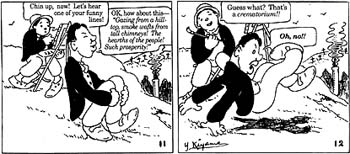![[Metroactive Books]](/books/gifs/books468.gif)
[ Books Index | San Jose | Metroactive Central | Archives ]
Migration Manga
Rare rediscovered Japanese comic chronicles an immigrant saga
By Richard von Busack
RESCUED FROM OBSCURITY, The Four Immigrants Manga ($12.95; Stone Bridge Press, P.O. Box 8208, Berkeley, CA 94707) is the most remarkable comic-book reissue of the year. The Four Immigrants Manga was rediscovered and translated by Dr. Frederick Schodt, the author of the best study of Japanese comics in English, Manga! Manga!.
Schodt found Henry (Yoshitaka) Kiyama's illustrated memoir deep in an archive at the UC-Berkeley library. Kiyama, a Japanese immigrant to Northern California, wrote the book about his first 20 years in this country. Published by a small press in 1931, Kiyama's book never made its mark in local history. The author returned to the town of Neu, Japan, where he spent the remaining years of his life.
As Schodt notes, Kiyama wasn't much of an entrepreneur. The book is written in slangy Japanese with plenty of English words added to the mix. Thus it would be equally difficult to sell in Japan and America. Kiyama, who was enthusiastic about Western art, drew his pictures in the brassy style of the early-20th-century funny papers. George McManus' once-popular strip, Bringing Up Father, about Jiggs, a nouveau-riche Irish immigrant with a social-climbing wife, must have been the model for Kiyama's art.
The story chronicles four Japanese friends who arrive in San Francisco on the same boat early in this century. The four take English names. "Henry" plans to study Western fine art, just as Kiyama did. "Fred" wants to be a farmer, like the Delta potato king Ushijima. "Frank" seeks a place in the import/ export business. "Charlie" means to study democracy in hopes of helping Japan out of its medieval ways.
Educated as they are, the four end up in menial jobs: housecleaning and potato peeling. They prove comically inept even at this work. The English phrase they learn first is "Go home." When Charlie and Frank become farm workers, they are stabled with the horses in the Delta rice farms and are later run off a Turlock pumpkin farm by a group of vigilante farmers.
In other adventures, the newcomers survive the earthquake and fire in San Francisco and visit the great Panama-Pacific International Exposition, the 1915 fair celebrating the city's rebirth. Taking chances on risky investments, the immigrants lose their money in Colusa rice farming and in banks that go bust. At the end, the group meets for a dinner together as Henry and Fred head back to Japan, while Charlie and Frank stay behind, immigrants who have made a life for themselves.
The Four Immigrants Manga is one of the first autobiographical comic books. It is also a rare first-person account of Asian immigrants to America. But perhaps the comic book's rarest quality is the way it records Miyama's uncensored attitude toward his adopted country. Generally speaking, students of the immigrant experience are fed positive tales of hard work, self-sacrifice and the need to suffer racism with a glad, forgiving heart. You might expect The Four Immigrants Manga to be one of these tales. You'd be wrong.
KIYAMA IS FRANK in revealing his flaws and those of his friends--their skirt-chasing, gambling and carousing, their lazing around between jobs. At times, Henry is a snob, cold-shouldering Japanese farmers who arrive broke in San Francisco. He also records his own unchristian thoughts about the Yankees, who look at him with condescension and dislike.
A word that comes up again and again in The Four Immigrants Manga is keto--a term Schodt translates as "hairy, smelly whities." As a proud member of his ancient race, Henry looks down his nose at the Chinese and resents being lumped together by the whites with people he believes are his inferiors. On one page, Kiyama lifts the lowest gag from Buster Keaton's film Seven Chances. Henry is trailing after a woman he likes through a crowd and taps her on the shoulder, only to find to his horror that she's kurato--black.
As Schodt writes, there's something in The Four Immigrants Manga to offend everyone. Schodt hastens to apologize for the racism, adding that Kiyama learned to draw African American and Chinese stereotypes from the newspapers of the day. But the ugly side of the immigrant experience rounds out The Four Immigrant Manga and makes it more than just an interesting antiquity.
Part of the reason history bores so many people is that no one can identify with superior beings who survived oppression with calm and untroubled spirits. I think it's impossible to imagine how our ancestors lived if we think of them as paragons, even if that's the way so many of them would prefer to be remembered.
We should never forget their ignorance as well as their endurance. Kiyama brings up some bits of history that Euro-Americans would love to forget, such as anti-immigrant and segregation laws passed in California that were so blatant that Theodore Roosevelt himself had to intervene to pacify the Japanese government. The story ends in 1924 for a reason: that's when all Japanese immigration to America was banned by President Coolidge--a decision that played a part in the origins of World War II.
It's too bad that Kiyama's narrative concludes without a sequel. This unselfconscious, never self-pitying man is a minor master of the cartoon form. Despite his prejudices, he and his friends are funny, likable, sympathetic tour guides to the past, and I felt richer for having been in their company for a couple of hours.
[ San Jose | Metroactive Central | Archives ]
Copyright © 1999 Metro Publishing Inc. Metroactive is affiliated with the Boulevards Network.
For more information about the San Jose/Silicon Valley area, visit sanjose.com.
![]()

Haiku Hill: A poetic moment from 'The Four Immigrants Manga.'
From the June 3-9, 1999 issue of Metro, Silicon Valley's Weekly Newspaper.